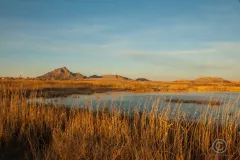How Hurricanes Shape Wetlands in Southern Louisiana

We all know that hurricanes can have destructive effects on human communities and infrastructure—but what about their effects on coastal wetlands? Until Hurricane Katrina, no one had ever mapped hurricane-caused land loss in Louisiana, where a staggering 90 percent of coastal wetland loss in the United State's contiguous 48 states occurs. The first study to do so, published in 2009, found that the almost back-to-back hurricanes of 2005 (Katrina on Aug. 29 and Rita on Sep. 24) and 2008 (Gustav on Sep. 1 and Ike on Sep. 13) caused an estimated 328 square miles (850 square kilometers) of coastal land loss in Louisiana—an area the size of more than 150,000 football fields.
While land's edges on a map seem well-defined and permanent, coastlines are always shifting. Sometimes natural processes or people extend the coastlines. But more troublesome is land loss. As wetlands diminish, ecosystems and human society suffer from the loss of their many benefits. Wetlands are home to a variety of mammals, fish, shellfish and amphibians and a haven for migratory waterfowl. The many fish and shellfish caught in Louisiana fisheries—the second largest in the nation behind Alaska—rely on the state's coastal wetlands for food and habitat. They act as natural pollution filters, and provide storm and flood protection. Without the wetlands in south Louisiana, over two million people would lose their livelihoods and many more organisms would lose their homes.
While hurricanes aren't likely to entirely remove the wetlands, they are able to do significant damage. Their powerful winds, rainfall and rushing floodwater can do enough harm to permanently remove land. The pounding surf can break down marshes' soft sediments and thick mats of dead grass, which are pliable and easily reshaped. Sometimes channels of fast-moving water flow to inland areas, which never again dry up—contributing to permanent land loss. Rushing wind and water can compact or move mats of grass and mud, while carrying smaller clumps of dead marsh plants to interior marshes or shorelines. And when saltwater floods into freshwater marshes, the wetland plants and animals can undergo temporary or long-term changes as the water chemistry changes around them.

With so many factors at play, it can be difficult to work out the effects of specific storms on wetlands and, in particular, their contributions to land loss. But, thanks to high-resolution satellite images, we are starting to learn more about the fine-grained impacts of hurricanes. My colleagues and I compared satellite images of the Louisiana wetlands before and after hurricanes Katrina, Rita, Gustav and Ike, and created two kinds of specialized maps: one shows the fraction of water in any given area, and the other distinguishes land from water pixel-by-pixel. By comparing the changes in each pixel during the five-year time period, we can tell the difference between land/water changes that are temporary and those that are more permanent. A pixel that has changed from land to water after a storm event and remained water in subsequent years represents persistent land loss due to that storm event. But a pixel that changed from land to water and then back to land signifies short-term change, representing either seasonal or post-storm recovery.
And what did we find? Hurricane Katrina did major damage to coastal wetlands that the other storms helped to reinforce. Katrina's 200 miles per hour winds, long duration (20 hours), and storm surge depth of up to five meters (16 feet) caused widespread erosion that permanently altered the shape of marshes in southern Louisiana. In addition, freshwater marshes—such as many of those impacted by Katrina—are more sensitive to land loss from hurricanes than saltier marshes. This is because their soil, made of decomposing plants, is more easily washed away than the heavier clay-like soils found in saltwater or brackish marshes. In comparison, Hurricane Rita's smaller surge one month later did not contribute much additional damage, only reinforcing the effects of Katrina.
The maps then show three years of recovery between 2005 and 2008, with marsh plants growing back and abundant new vegetation colonizing the shallow ponds formed by Katrina—until more storms hit. While little new land loss occurred from hurricanes Gustav and Ike in 2008, their forces mostly removed the regrown vegetation, reversing three years' worth of marsh recovery in a two-week period. Fortunately, southern Louisiana has not experienced any major hurricanes since then, so we expect that recent images will show some lasting marsh recovery, at least until the next storm arrives.
References:
Barras, J.A., 2007, Satellite Images and Aerial Photographs of the Effects of Hurricanes Katrina and Rita on Coastal Louisiana, US Geological Survey Data Series: 281.
Barras, J.A., 2009, Land Area Change and Overview of Major Hurricane Impacts in Coastal Louisiana, 2004-08: US Department of the Interior, US Geological Survey Scientific Investigations Map 3080, 6 p.
Morton, R.A., and Barras, J.A., 2011, Hurricane Impacts on Coastal Wetlands: A Half-Century Record of Storm-Generated Features from Southern Louisiana: Journal of Coastal Research, v. 275, p. 27–43, doi: 10.2112/JCOASTRES-D-10-00185.1
Palaseanu-Lovejoy, M., Kranenburg, C., Barras, J.A., Brock, J., 2013, Land Loss Due to Recent Hurricanes in Coastal Louisiana, U.S.A. : Journal of Coastal Research, 63(sp1):97-109, doi: 10.2112/SI63-009.1
U.S. Department of Interior, 1994, Chapter 8: Coastal Louisiana in The impact of federal programs on wetlands, a report to Congress by the Secretary of the Interior, March 1994





